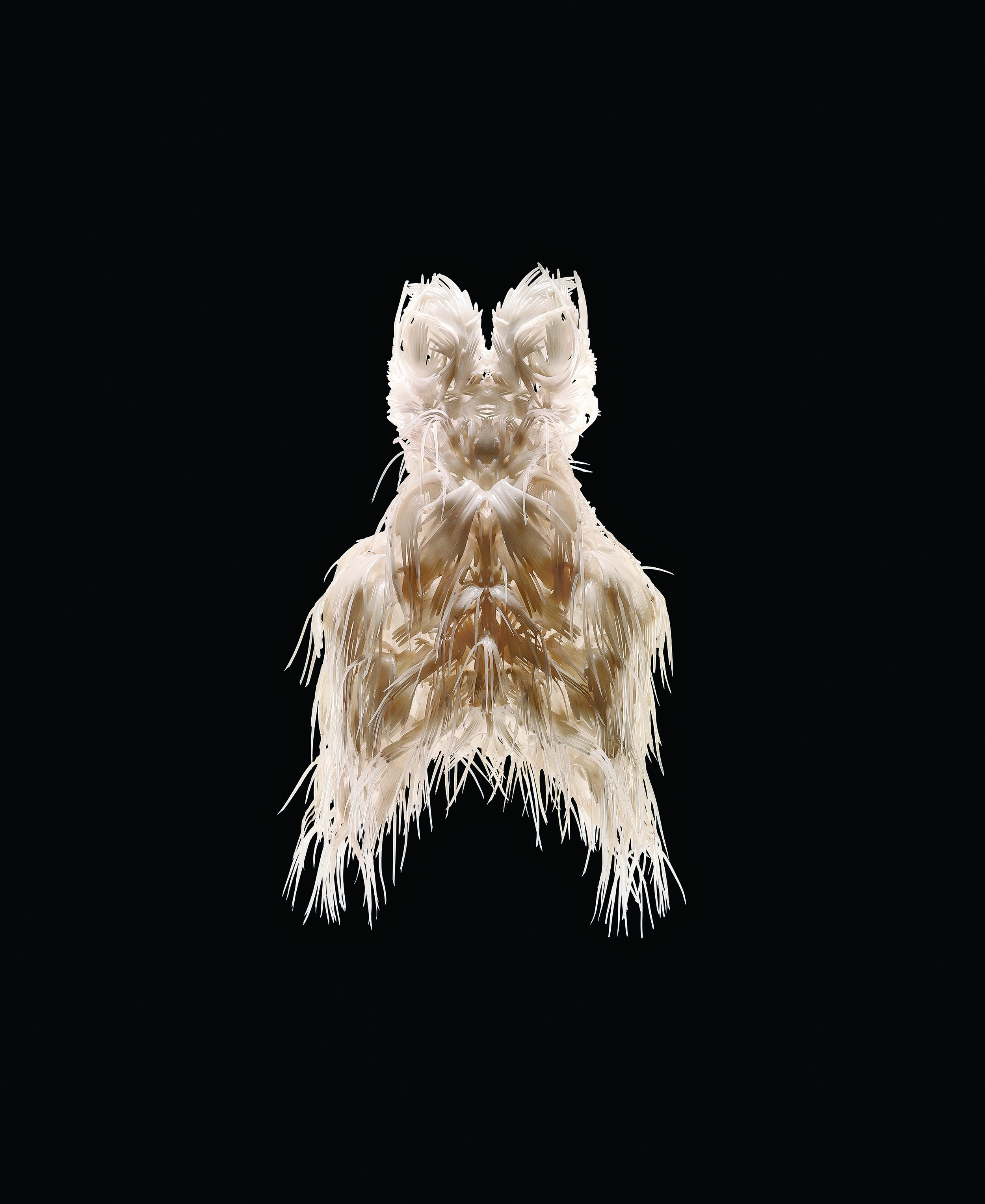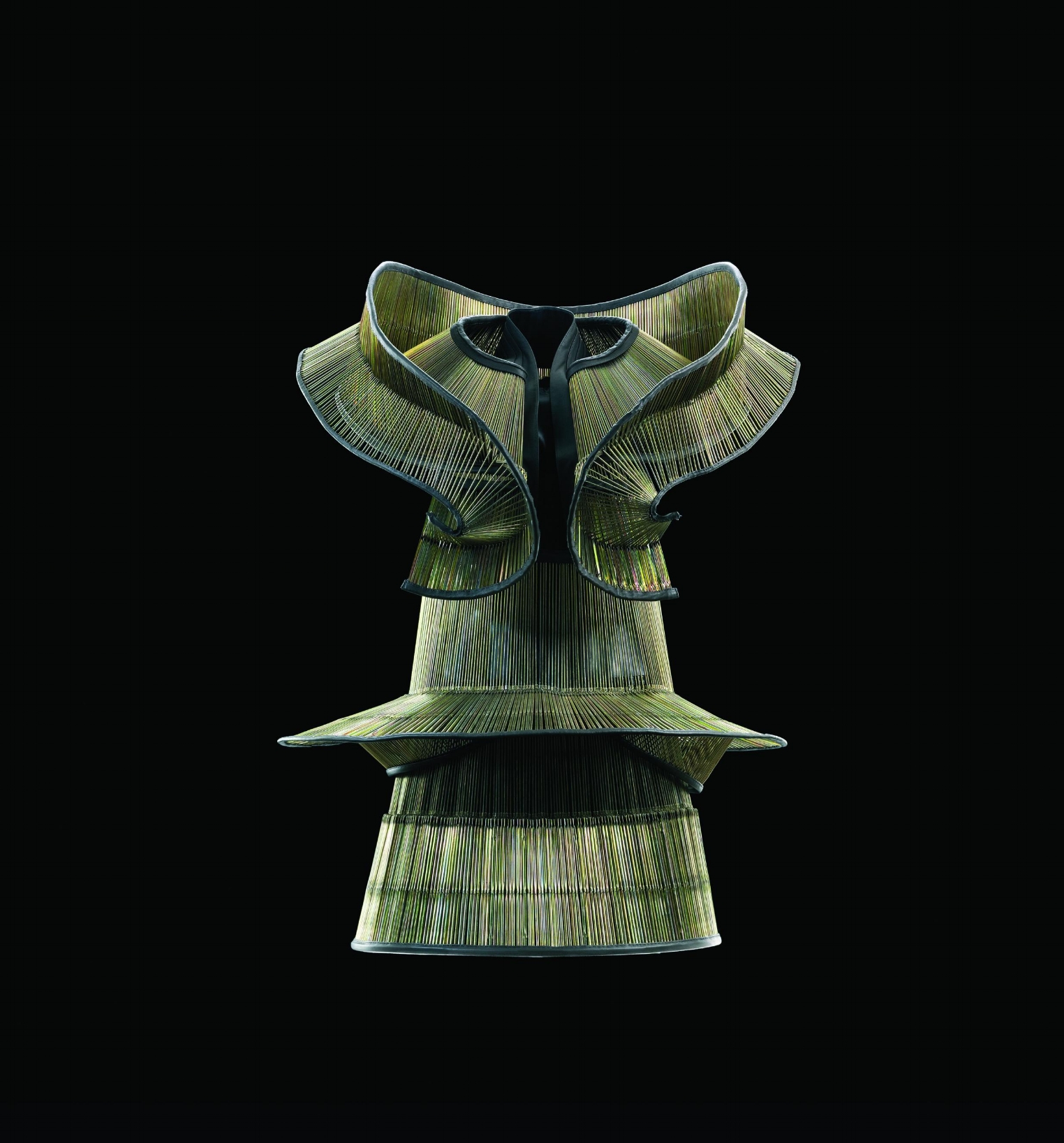Exhibition Review: Iris van Herpen: Transforming Fashion
Phoenix Art Museum (Arizona), February 24-May 13, 2018
Originally curated by Sarah Schleuning from the High Museum of Art in Atlanta, Georgia and Mark Wilson and Sue-an van der Zijpp from the Groninger Museum in the Netherlands, Iris van Herpen: Transforming Fashion was a focused look at the designer’s work since 2008. With a total of 45 pieces from 15 different collections, Transforming Fashionhighlighted the pioneering spirit of van Herpen’s innovative designs in fashion and left visitors with a strong impression of the breadth of her revolutionary vision. Iris van Herpen creates a visionary present that is simultaneously “now” and “then.” Each of her collections builds from the last, cultivating concepts so that there is a clear and consistent thread that ties them all together. Distilled to an essence, van Herpen’s garments convey an unmistakable relationship between the body and technology which is synergetic and, more than anything, beautiful.
Having determined that it was absolutely essential that I experience Iris van Herpen’s groundbreaking artwork in person, I set out from San Diego to drive across the Arizona desert to see the exhibition. With no offense intended, my first question to Dennita Sewell, Jacquie Dorrance Curator of Fashion Design at the Phoenix Art Museum was, “Why is this exhibit here in the middle of the desert?” Why did this show elude all of the major cities in which one would expect to see an exhibition like this one? According to Sewell, van Herpen herself felt that her work needed to be taken to new audiences, away from the metropolitan centers that were more obvious havens of technology. It was important that her designs be showcased in institutions that share her own feelings and commitment towards visionary design. Sewell also mentioned that for the Phoenix Art Museum specifically, van Herpen’s work “embodies the future of fashion,” and by collecting and displaying the work of designers and artists like her, it keeps the museum “in sync with what is creative and cutting edge.” The museum, in fact, proudly owns and lent to the exhibition a dress from van Herpen’s 2014 Biopiracycollection, which is a major asset to their fashion holdings for which they actively collect.
The exhibition design was exceedingly simple, albeit sparse, creating an unencumbered background to view the complexities of the designer’s work. Viewers were able to get up close—admittedly too close on my part—to the garments and really examine their details. Even the mannequins were specially treated, as per Iris’ request, to have skin-like coverings that matched the pattern and texture of the treated leather on a dress from the Radiation Invasioncollection that was on display in the exhibition. While full head-to-toe styling on mannequins generally instills a more thorough impression of a design, each of van Herpen’s garments is so multi-faceted in design, material, and texture that it would have been overwhelming to view the garments and accessories all at once. It was helpful to have examples of van Herpen’s impossible-looking footwear displayed separately and shown in raised display cases that are viewable at eye level. A video compilation of van Herpen’s runway shows interspersed with interviews played at the entrance to the exhibition which assisted the viewer to fully flesh out the pieces on display into the full looks from her collections. These video clips also demonstrated the range of the body’s movement in her garments and the specific, unique movement of the garments themselves.
In spite of my own trepidation at donning any of van Herpen’s designs in my real life, I was particularly impressed by the attention and adherence to the natural lines and curves of the body that is evident in their construction. While they may be incredibly intimidating given the intense drama that surrounds them, each piece is weirdly wearable-looking. Besides the technological aspects of the garments that overwhelmingly command attention, what is pleasantly surprising about van Herpen’s designs is their attention to the body and careful scrutiny of physical form. They showcase smart design that is cognizant of assets like hips, shoulders, and waists which are often accentuated. Beyond that even is an awareness of complex forms that show skeletal and muscular detailing. Most likely due to her childhood experience studying classical ballet, it is obvious that van Herpen’s designs are sensitive to the natural movements of the body. In photographs and on mannequins, her pieces look conceptual to the extreme; however, when viewed in full motion on the runway, these garments are very much alive and interactive with the body wearing them.
Van Herpen infuses technology into fashion in such a way that no other contemporary designer does. Mistakenly, many people are quick to assume that the incorporation of technology with fashion implies “fast fashion” and mass production, and that craftsmanship and construction are not prioritized. One point of pride in van Herpen’s work is her astounding attention to details that can only be manufactured by hand. For example, in a dress she made for one of her first collections in 2008, Chemical Crows, van Herpen hand tied the tines of umbrella frames together to create sculptural representations of bird wings. Fashion that embraces an inherent connection between humans and their environments, both natural and constructed, is the fruit of van Herpen’s labor. Her astute observation that the future is, in fact, now allows her to transcend conventional fashion design with unexpected and wholly original materials. Her design sensibilities also demonstrate that she is in tune with society’s preoccupation with technology and showcases her flexibility when it comes to Her designs demonstrate the body’s comfort with technology that already exists in society today considering the permeation of mobile phones and other vehicles of technology that we interface with daily.
Van Herpen’s distinctive enthusiasm for interdisciplinary projects sets her further apart from other contemporary designers. Her arsenal of collaborators is stocked with scientists, architects, 3D printing companies, and other artists who contribute to the concepts and materials that comprise her creations. Her invented materials are often the result of trial, error, and constant development with the help of people like Dutch artist, Jólan van der Wiel, who blended resin with iron filings to create the material for a dress in the Wilderness Embodiedcollection from 2013, which could be pulled up by magnets into crater-like shapes for a unique texture. Selected samples of the materials used in van Herpen’s garments are on display in the exhibition and available in a tactile display for visitors to experience. This area was designated as an interactive, touch-tank style display where visitors could use their hands to touch pieces of metal-infused resin material used to create the Wilderness Embodieddress and handle the photopolymer and stereolithography resin that makes one of the dresses from the Magnetic Motioncollection from 2014. To feel the rubbery texture is a mind-bending experience when you visually perceive a metallic material that looks like it must be heavy and sharp. This was one of many jilting textural experiences I had when grabbing at every piece in that particular display.
While we are generally bombarded with projections of a bleak, apocalyptic forthcoming landscape, Iris van Herpen’s refreshing vision of a future where humans engage more deeply with the world around them seems more utopian and productive. Van Herpen’s marriage of the natural and the manufactured is a thrilling experiment in contemporary fashion and her work pushes boundaries at every angle. This exhibition left a penetrating impression that whether you are a designer, scientist, or really anything, it is imperative that you forge ahead in your field with an open mind and that innovation is beyond value. Transforming Fashionwas a thoughtful meditation in what fashion can be when it transcends the parameters of its own discipline and recognizes the potential in cross-engaging the capabilities of science and technology.





